Using Catalog Ads as a beauty and cosmetics brand
January 30, 2024
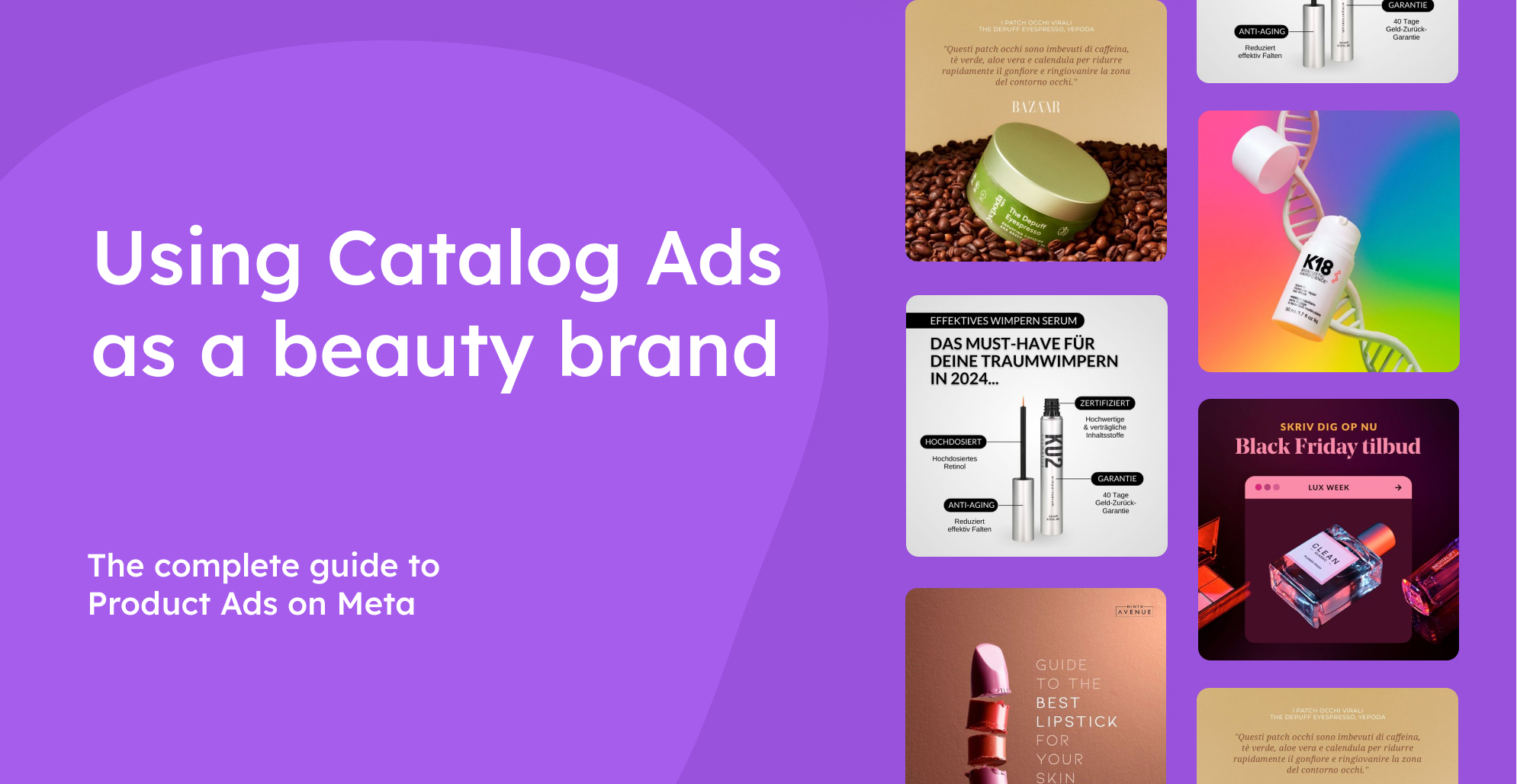
For beauty brands - even more so than for many other industries - the look of your ads can be everything.
And that's exactly why we've built the following Catalog Ad playbook for beauty brands, just like yours.
Below, we've collected a handful of Advantage+ Catalog Ads from beauty brands that not only are gorgeous to look at but also leverage all sorts of time-tested advertising tactics that really work!
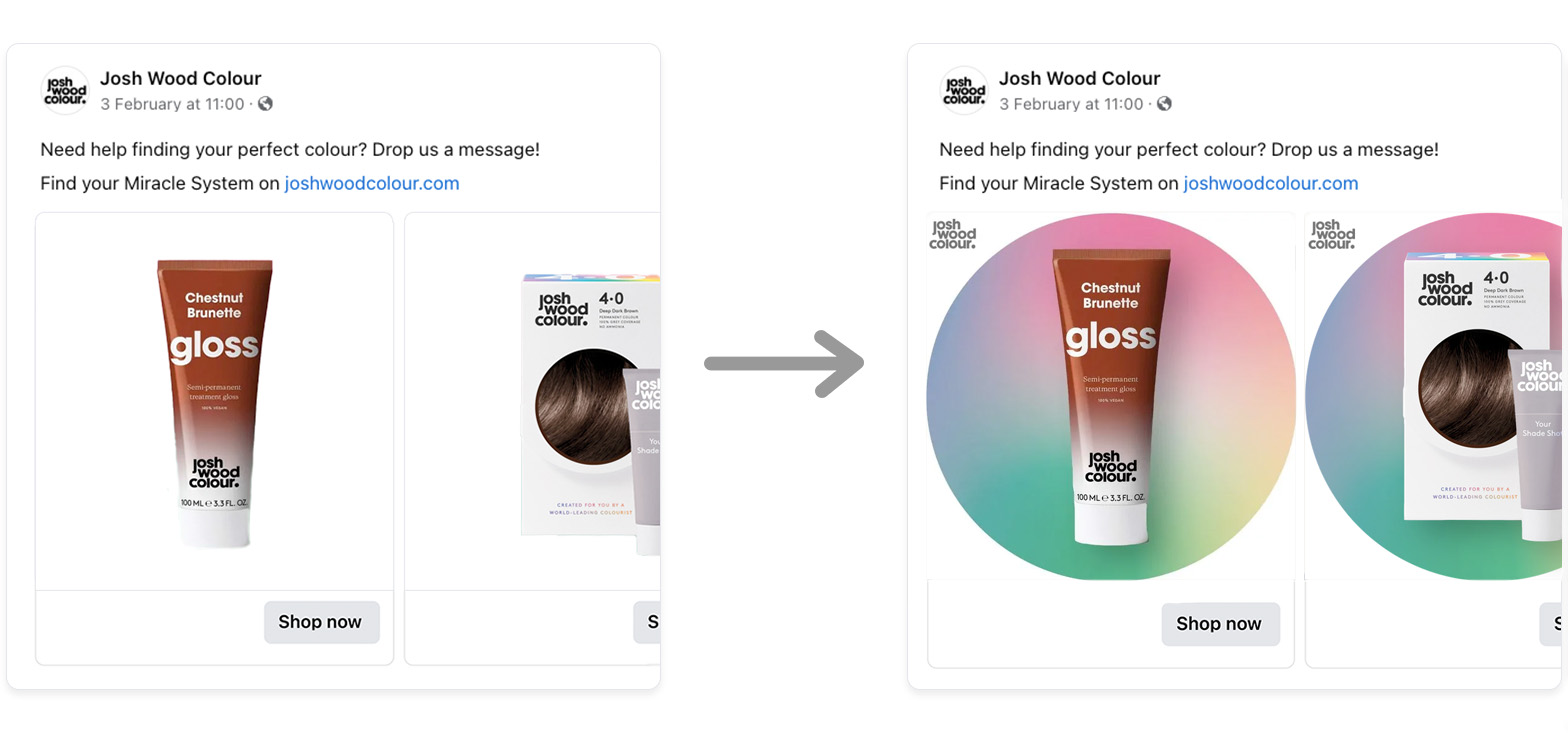
Obviously, the trick here isn't to simply copy these ads and hope for the best.
But you should use the following guide as inspiration for your next Catalog Ad, using only the tactics and strategies that make the most sense for your beauty business.
So, if you're a beauty brand and you are ready to level up your Catalog Ads, keep reading! This one's for you.
Always-on Catalog Ads for beauty brands
When we talk about always-on Catalog Ads, we're talking about the ads that aren't tied to any specific seasons, time frame, events, or other types of campaigns.
In other words, these are the ads that make use of evergreen designs so they can run all the time.
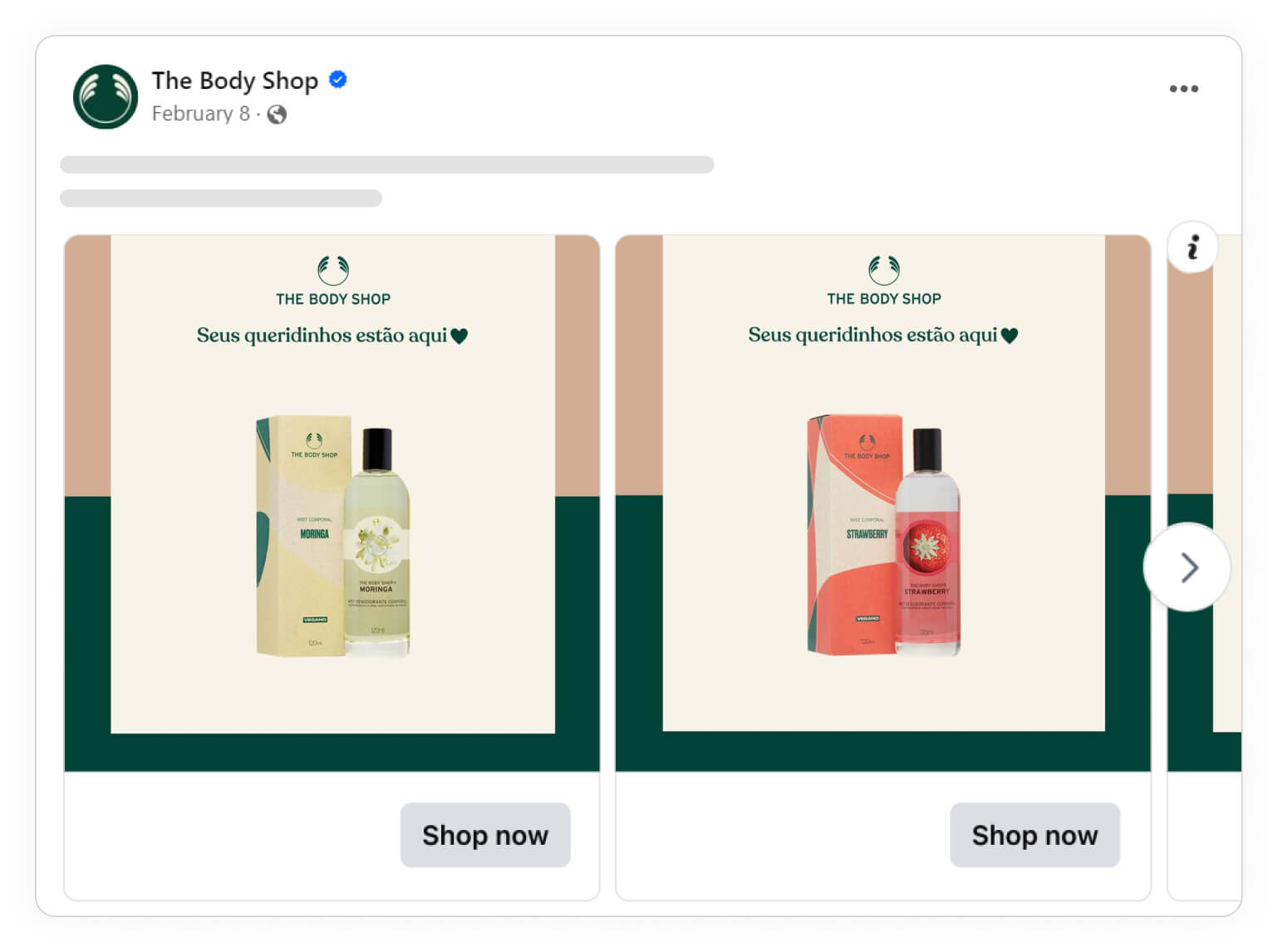
That being said, your always-on Catalog Ads are the ones that your audience will see the most often, and therefore, they're the ads that you should put the most time and energy into refining and perfecting.
But how exactly are you supposed to perfect your beauty ads?
Well, lucky for you, we've put together the following collection of always-on beauty ad examples, explaining the simple yet effective advertising tactics leading beauty advertisers are using every day.
It's a mix of simple tactics that are easy to implement to hardcore always-on tactics like this Maybelline example below, where they dynamically show the product on a model, together with the packshot on top of a background featuring the texture of their product.
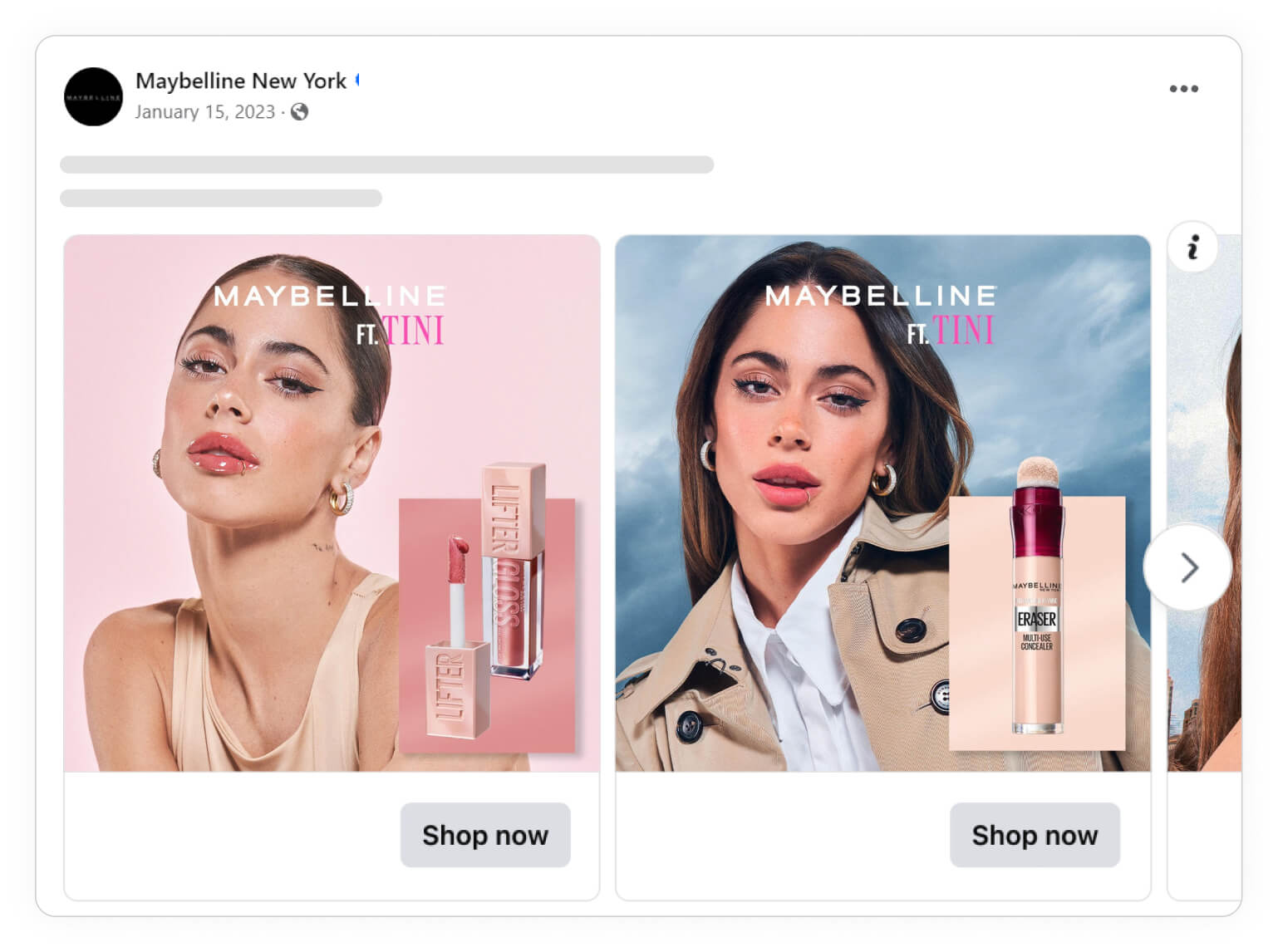
Let's take a deep dive into some different tactics you can use as a beauty- or cosmetics brand!
Show product information (prices, product name, etc.)
When it comes to creating beauty content that truly connects with your target audience, the trick is to provide information that they're most likely going to want to know.
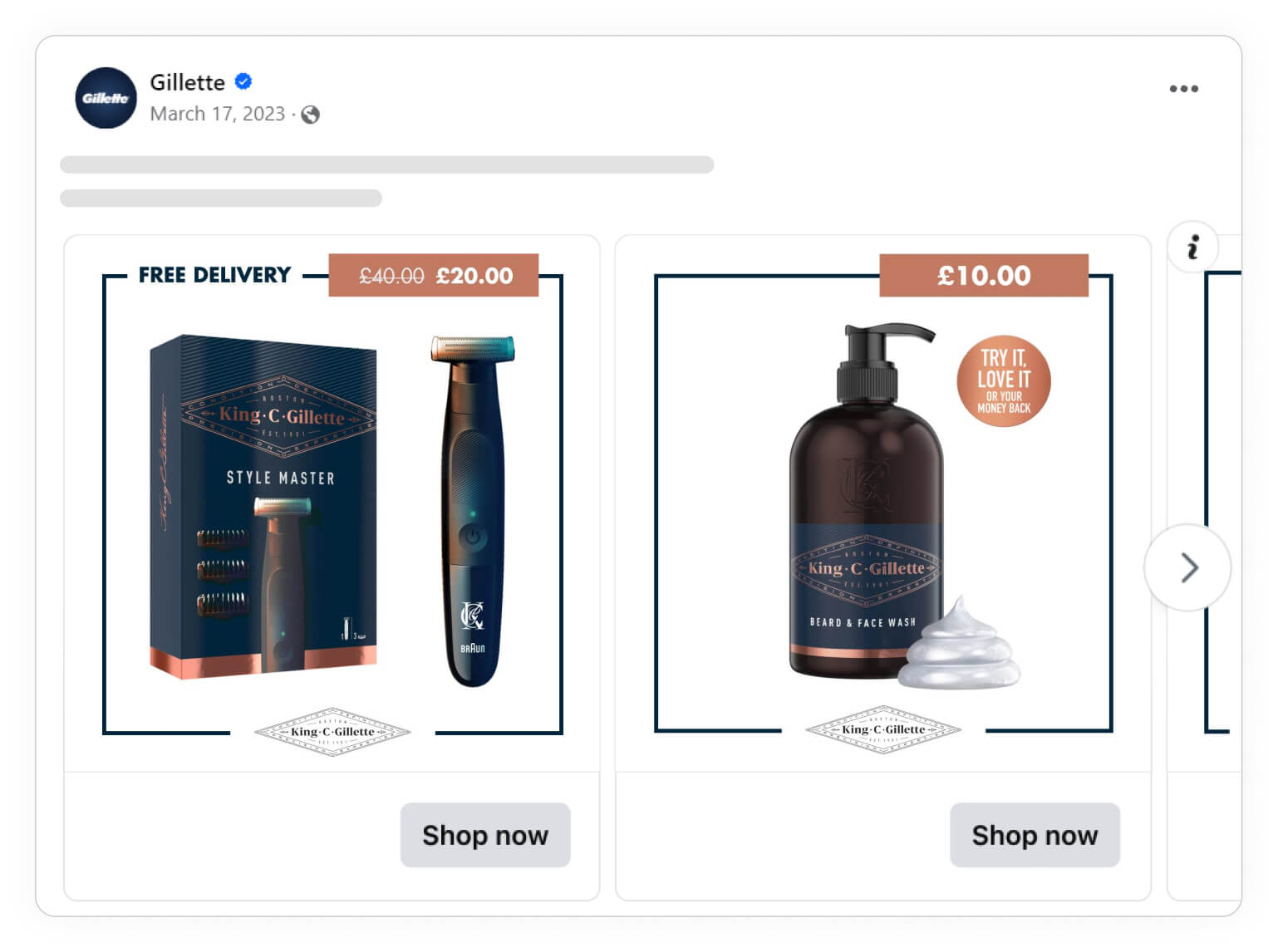
So, in many cases, showing prices and product names can be some of the best information to show, which will not only educate but will also qualify the viewer.
The idea is to use product information and data that you already have! That way, it's super easy to implement into your Catalog Ads.
Take the following ad from Smileship, where the advertiser includes the product's name and the price to qualify their viewers. This is an easy way to step up their design level above basic white-background packshots.
The product name isn't likely all that important, but it does help explain to the viewer what exactly they're looking at. And the price... Well, if the price is too high or too low for the viewer, they'll simply scroll on to the next products in the carousel. They weren't a good candidate for a click-through to that specific product.
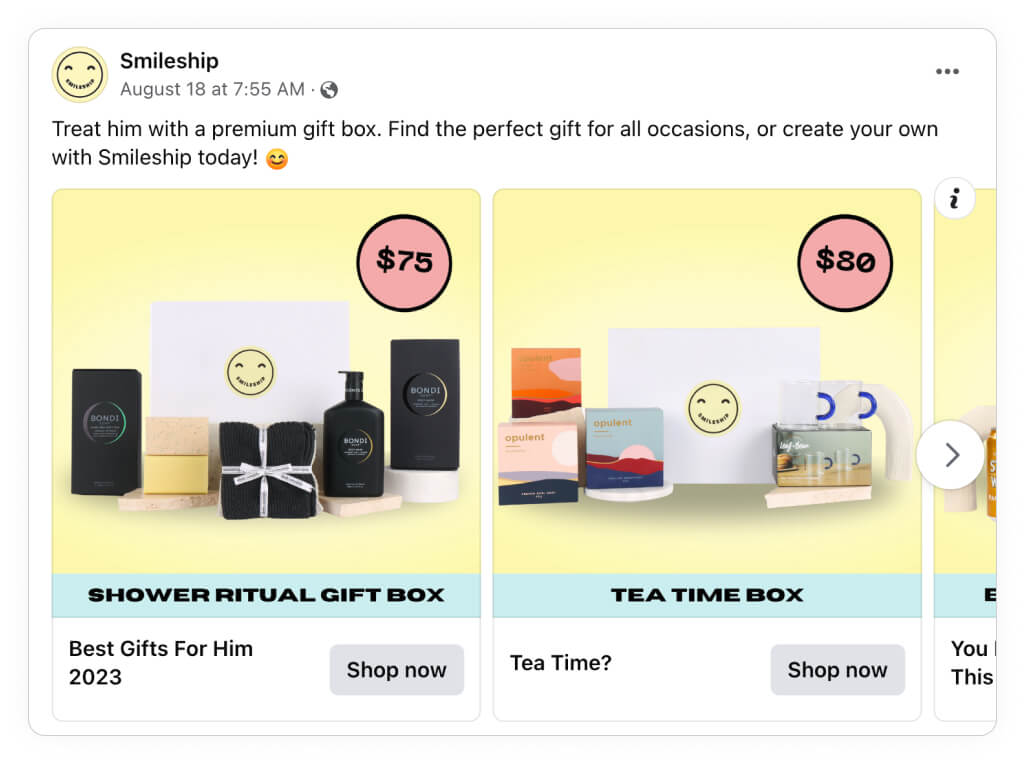
In essence, you can use information you already have to create a miniature version of the product page, giving the viewer ALL the information they might need to make a buying decision.
This is probably a better tactic for beauty brands with customers that have a shorter buying journey since you can entice viewer to convert just by looking at the ad; They don't even need to click-through to read any information on your site.
The information the consumer wants depends heavily on your product type and end consumer. Look at this Loreal ad, which has the size and shape of their product as the main USP - something important to professionals but not to the average consumer.
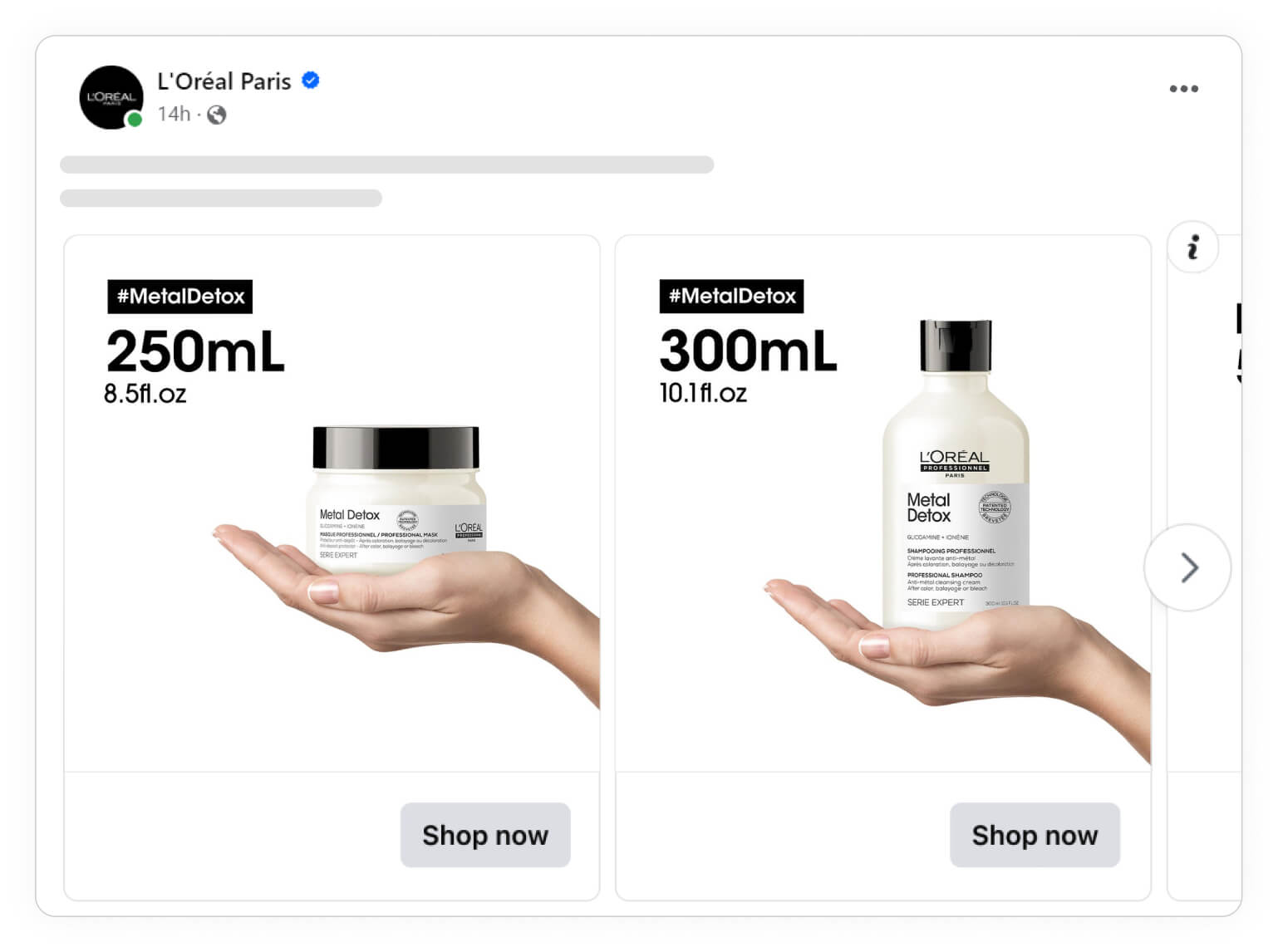
With Meta's focus on Advantage+ Shopping Campaigns, it can be a great tactic to show very specific USPs. Meta will target the right consumers based on the design, which is called "creative is the new targeting," so that people interested in the size and shape of these products will automatically be targeted.
Benefits:
- More information means you qualify who clicks on your ads.
- It's especially great for Advantage+ Shopping Campaigns
- You should have this data readily available
- It is an easy-to-implement tactic that can improve your ads.
Disadvantages:
- The ads can become very cluttered when adding too much information
- Showing information can backfire since irrelevant information is typically worse than no information.
The following ad is an example of how you can use product attributes to provide your viewers with valuable and relevant information. The ad includes not only the product name, but also the size, description, EDP, sales price, and the original price too - all the information you can imagine.
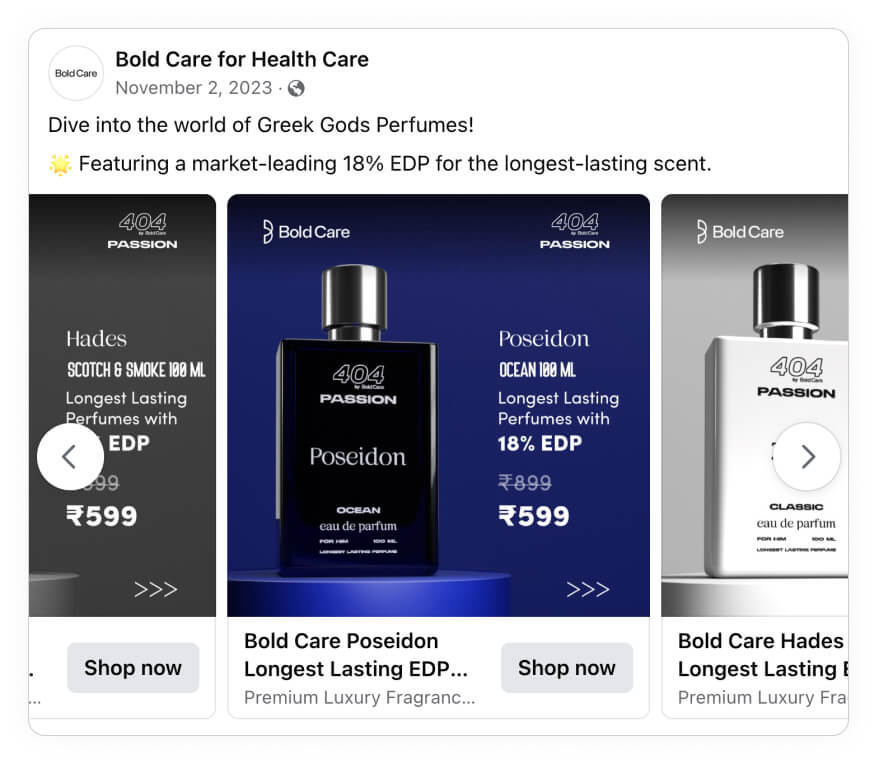
However, depending on what type of products you're selling, including too much information can be a problem. So don't automatically include every bit of information you can possibly dig up.
Again, the key here is RELEVANT information.
A more subtle way to provide information to the consumer can be via visual assets. To show an example, look at the Catalog Ad from RITUALS below:
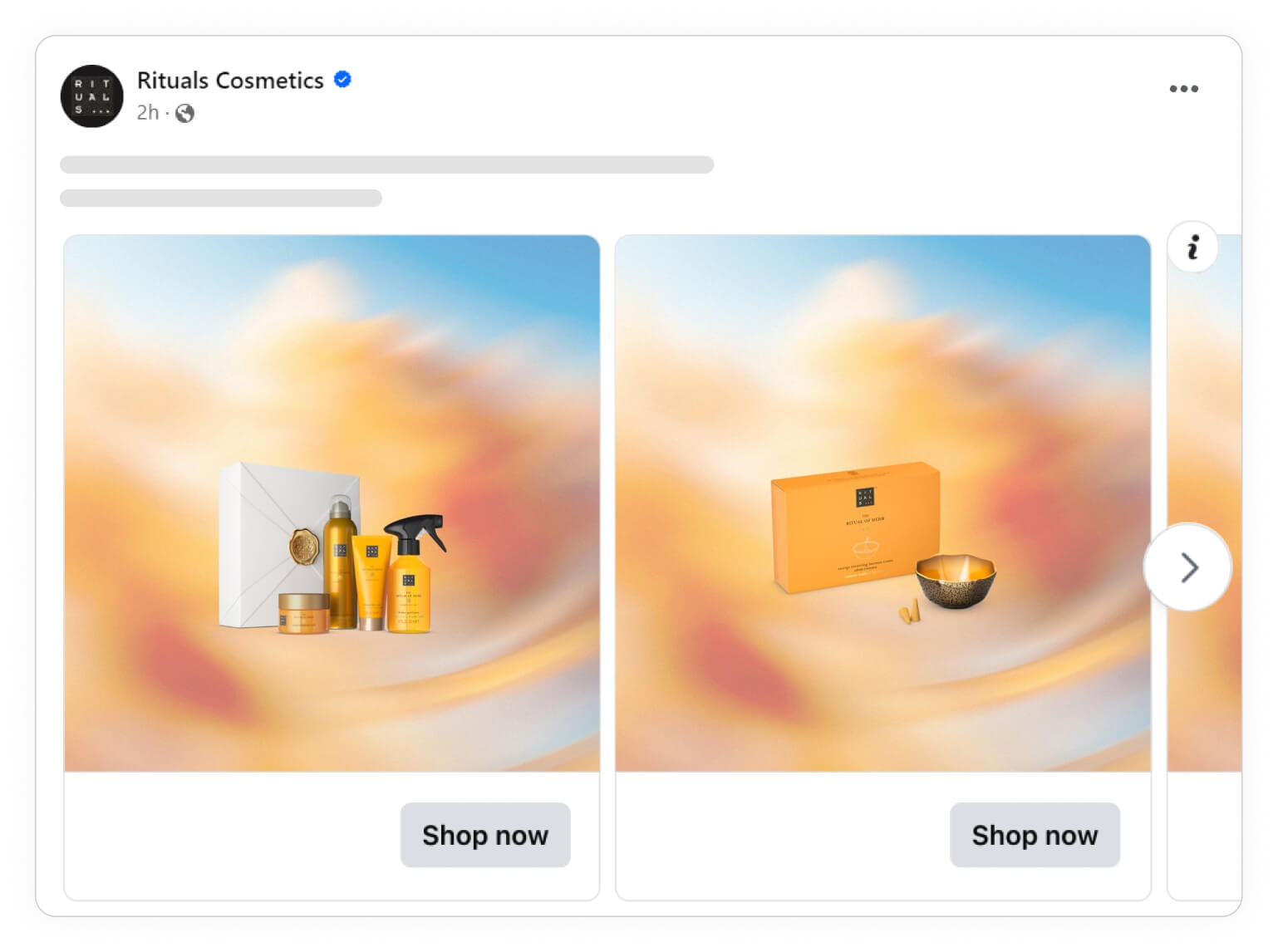
The background is carefully chosen to match the products - because it's from the collection called "the rituals of Mehr", reusing the exact brand assets and capturing the feeling of the collection fully.
This is very visible when you look at Catalog Ads from their other collections, like their Catalog Ads for their "the rituals of Karma" collection:
.jpg)
If your target audience is more interested in knowing they're looking at the correct product, they probably won't care much about the price. And in that case, it might make sense to do something like the following ad.
In the following Catalog Ad example, the advertiser shows the product name, and exactly who this product is for. This is relevant information that automatically qualifies who will actually click on the ad. In other words, this creates higher-quality traffic on your site.
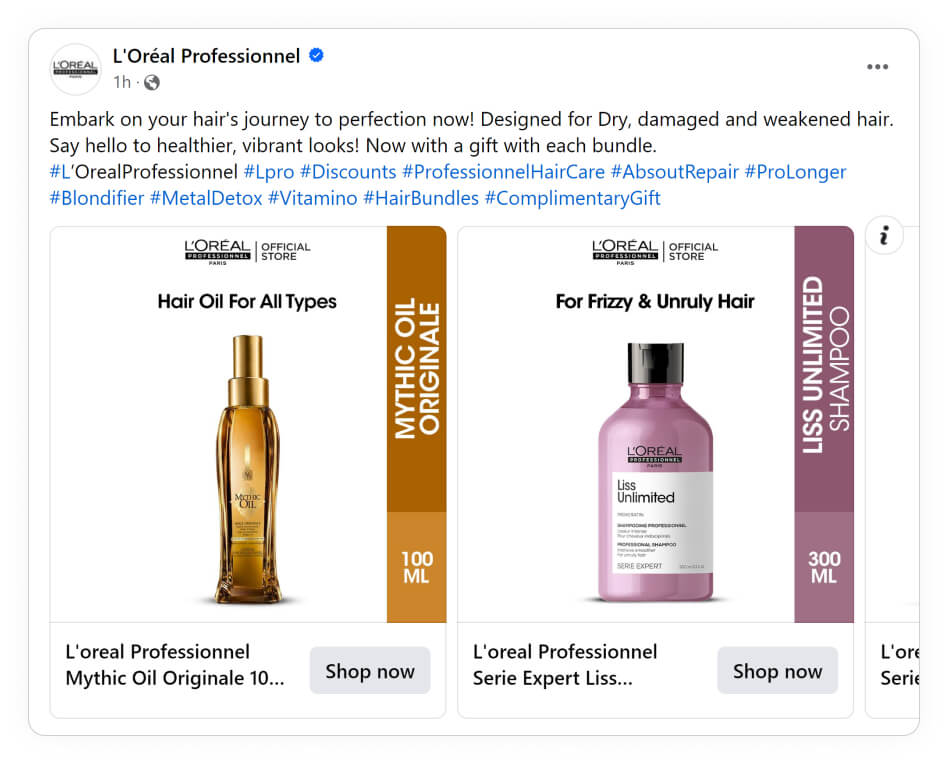
Show off your brand assets
In many ways, branding is the backbone of your business. From logos to colors to taglines, branding can be thought off as the face of your brand, representing not only who your are as a brand, but also what type of products you sell.
That said, there are many ways you can show off your branding in your Catalog Ads.
And the simplest way to go about it is to simply slap your logo on your ads and call it a day. Tada! It's now branded.
However, before including your logo in all of your beauty ads, it's important to consider whether or not your ad is recognizable and whether or not it adds any valuable information for the viewer.
So for beauty brands where their logo is a recognizable brand assets, this can often be a smart way to show off your brand.
We've even found that ads that show the advertiser's logo often perform as much as 43% better than similar ads without logos. But remember that showing your logo won't work all of the time.
Still, there are other interesting ways that you can show off your beauty brand's branding, just like in the following catalog ad from Schwarzkopf. Here, the advertiser shows a different catchphrase for each of the beauty products in the ad. But, they've kept things cohesive by using on-brand colors and by including their logo in the bottom corner.
The point here is that showing off your branding doesn't just mean showing your logo, no matter how beautiful it might be.
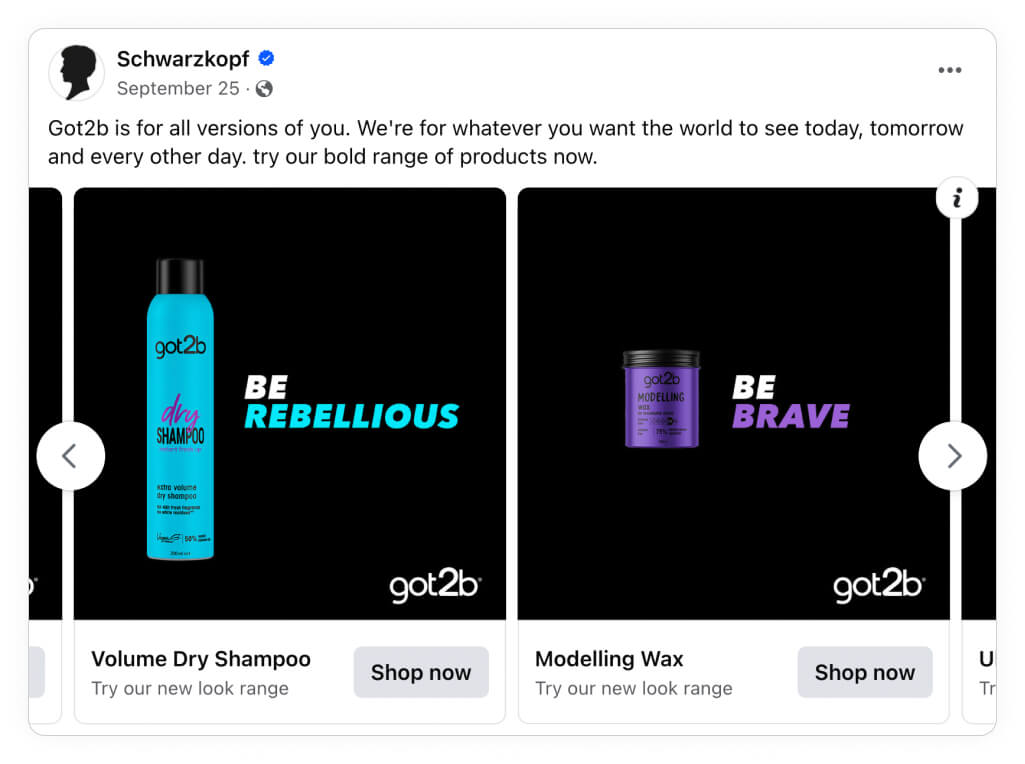
Next up, we have another Catalog Ad example that leverages the same concept of using a logo to make the ad more effective. Here, you'll see the advertiser used the brand's colors and logo in each ad, but the real kicker comes from combining that with the logos (and branding) from the companies that they're collaborating with.
This tactic is genius, especially since they're working with well-known beauty brands like MAC. This way, even if people aren't aware of your beauty brand, name-dropping the well-known cosmetic companies that you work with can help capture their attention.
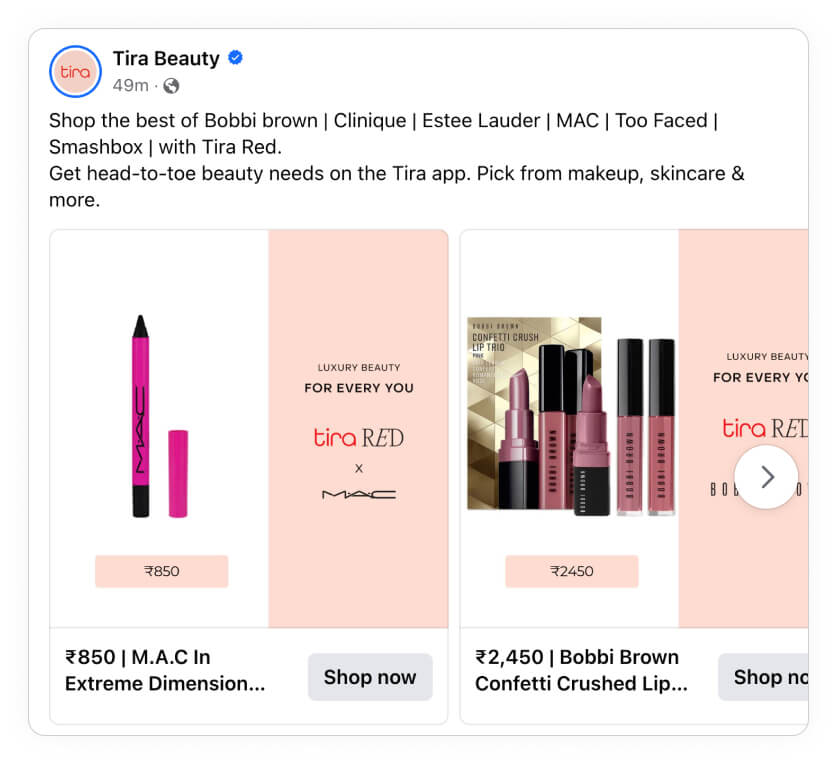
And finally, we have another example where the advertiser chose to create visually stunning, on-brand backgrounds for their ads. The beauty products change from one ad to the next, but the background is always the same, ensuring that the business' branding shines through in every one of their beauty ads.
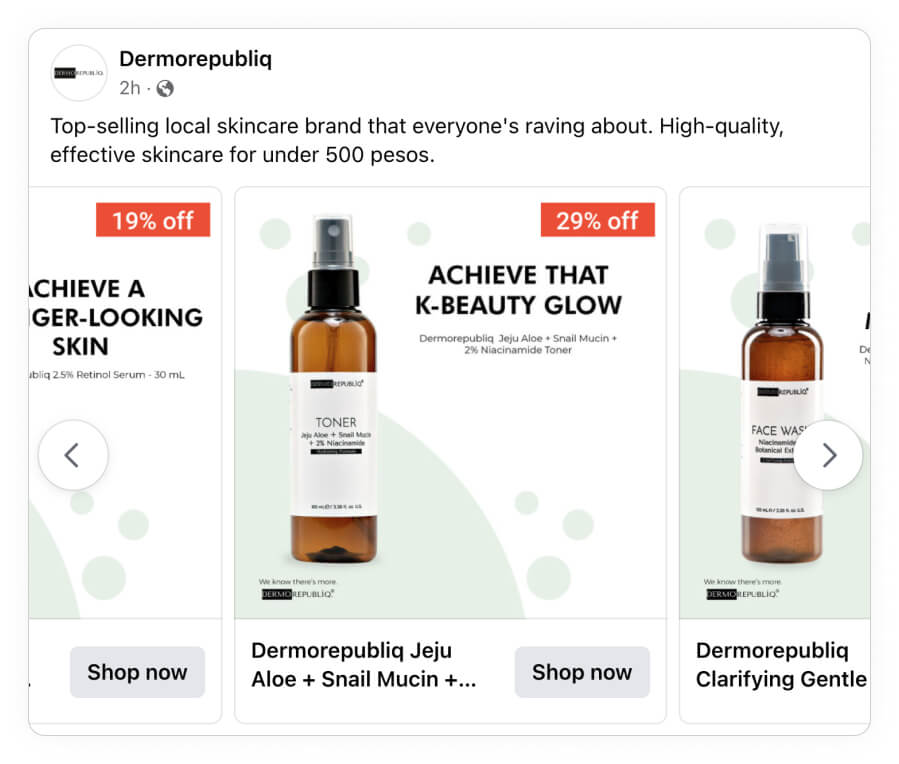
Just remember that brand assets, like your logo, can be used in a number of different ways to help make your Catalog Ads more memorable and more effective at selling your beauty products.
Let's recap:
Benefits:
- Logos can be used to build brand recognition so that people will remember you in the future.
- Name-dropping the bigger brands you work with can be an effective tool for building trust.
Disadvantages:
- Showing your logo or branding in your Catalog Ads won't always work, especially if you're a newer brand that most people don't know (yet).
Campaigns & Sales for beauty and cosmetic brands
Campaign sales are a great way for virtually any business to stir up some hype around holidays, seasons, or other time periods.
But why do they work?
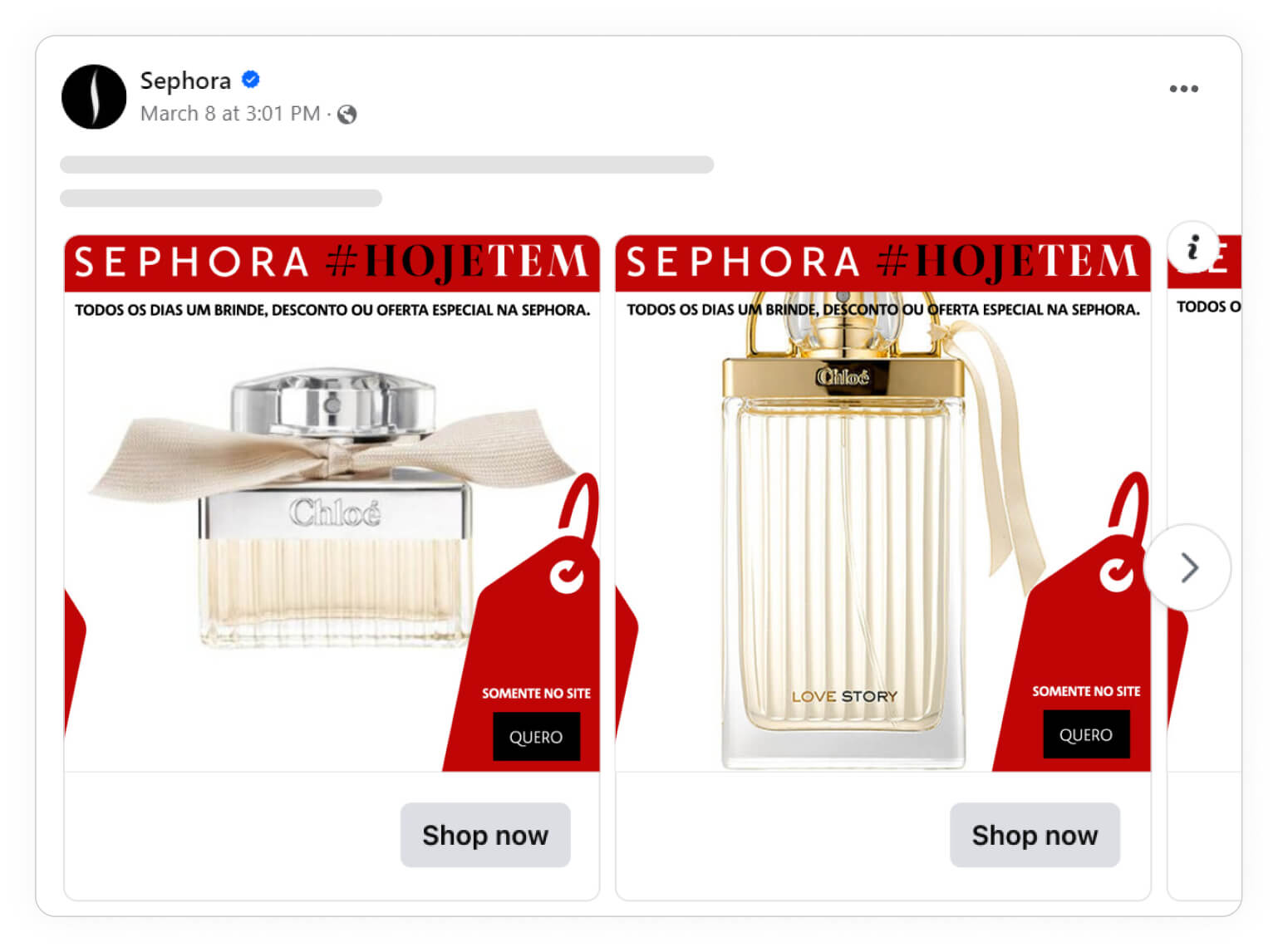
Look at this Catalog Ad from Sephora, which shows their daily offers. Every day, they had new discounts and sales on their site, which they showed via Catalog Ads (a smart choice since they are dynamic, updating hourly).
These type of ads typically works better because they only last for a limited time. And this helps to create a sense of urgency in the viewer that if they don't act now, they might miss out.
In other words, campaigns leverage the fear of missing out, or FOMO, to drive sales.
And the best part is that there are many different ways you can create campaigns that can boost your ad performance and generate more revenue for your beauty brand.
Campaign periods
The simplest and most common type of campaign is when beauty brands create Catalog Ad sales around certain holidays, such as Christmas, Easter, or in this case, Black Friday.
Everybody knows that Black Friday is one of the best days of the year to find great deals on products you love, like the hottest new lipsticks or eyeliners from Elf.
This is why creating catalog ads, like this one, around Black Friday can be a powerful motivator for your ad viewers. What we really love here, though, is the way this advertiser didn't just mention Black Friday, but they also designed their beauty ad with Black Friday colors, which helps make things more cohesive and relevant to the campaign period.
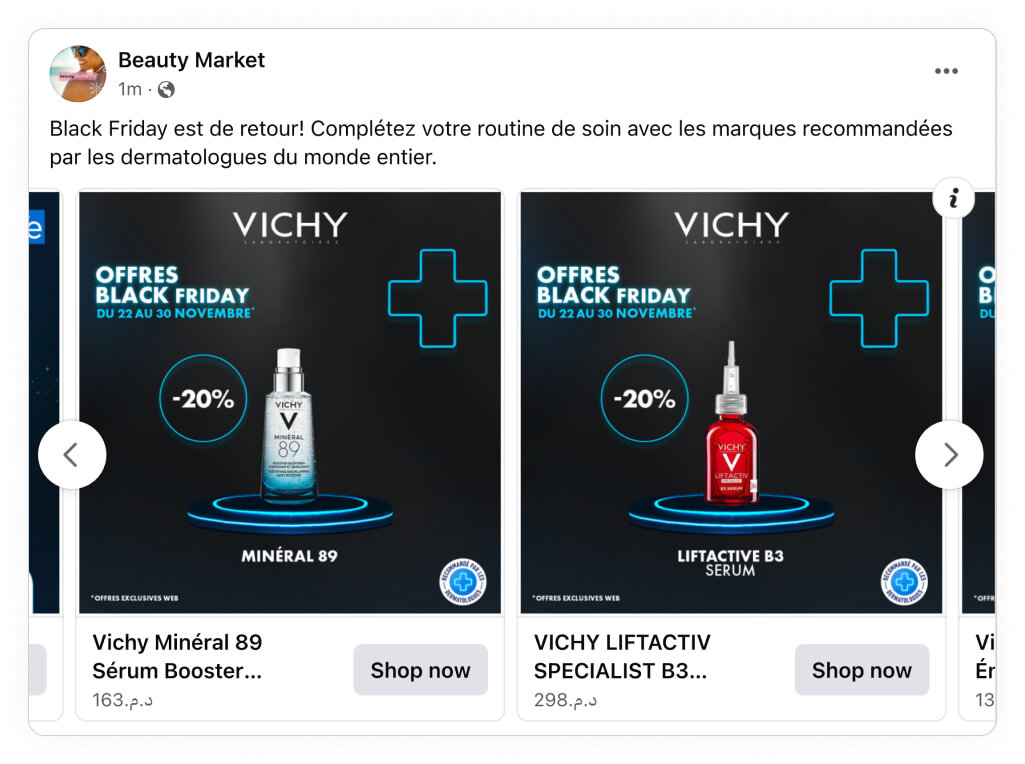
Similarly, you can also create campaign sales around different months, weeks, or yearly types of periods. Just like the following ad from StyleKorean Malaysia, where they've created a January sale to help boost revenue right at the start of the year. But they didn't stop there; they also included relevant pricing and product information, which helped screen and qualify who would click on the ad.
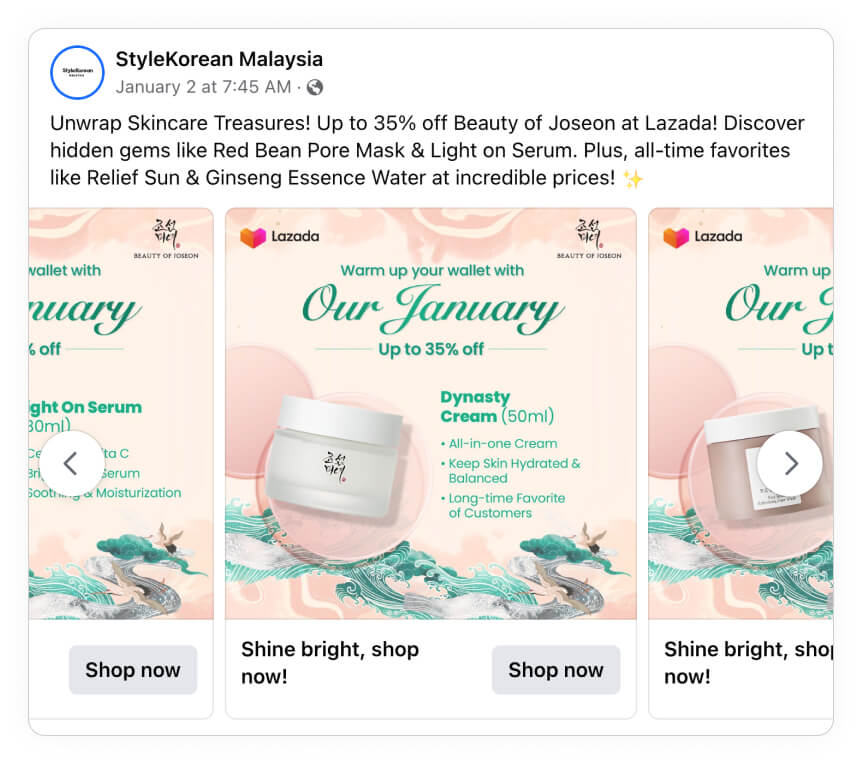
Of course, it doesn't only have to be January sales. It can be any month of the year. But just to drive the point home, take a look at this next ad example from Sundora Beauty that also promotes a January sale. What's really great about this January sale, though, is that the advertiser also included a number of other important elements, such as their logo, the product name, and they've even used a touch of pricing psychology to help make the product even more desirable.
The trick here is the wording they use and the way they present the price! First, they show that the discount is XX% off, but then they show the regular price and the new discounted price, which helps drive home just how much money the viewer will save if they act now.
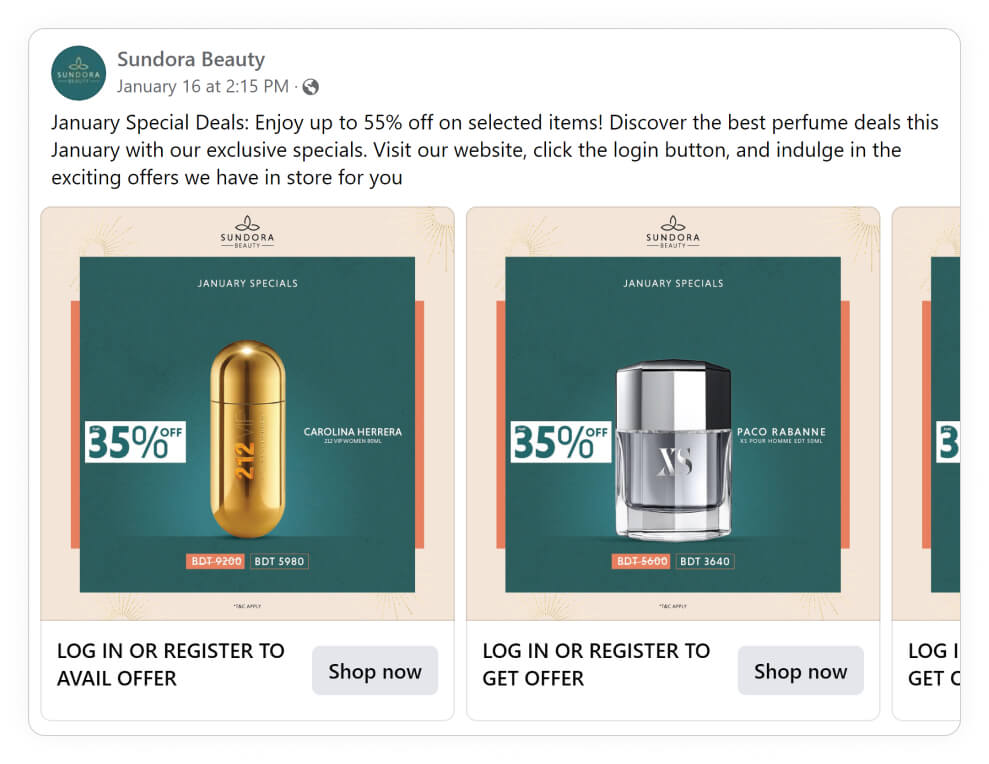
Time-limited campaigns for beauty brands
So we've already mentioned that campaigns can be a great way to create a sense of urgency around your beauty products and their sales.
In other words, your campaigns don't only have built around time periods, like a holiday or calendar event. They can also be built around limited-time only campaigns, which CAN be built around time period, or you can even INVENT your own time period!
For example, here we have an ad from Scents And Stories, where they've created a campaign around weekly deals. This is a common tactic you'll see out there, and it's effective because it can be used literally EVERY WEEK! You'll also notice the way they've included their logo and the wording they use to present the price.
By stating that discounts are "starting from..." they don't really tell you anything specific about the discount. This creates a sense of curiosity in the viewer, which can entice them to click through to find out more.
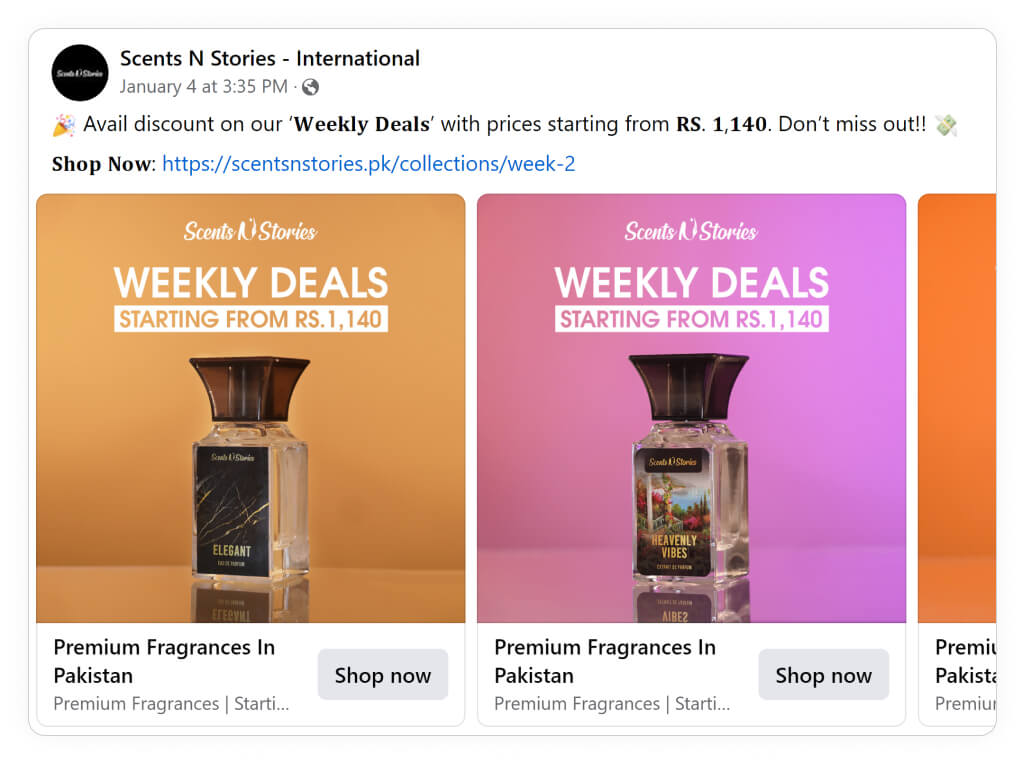
You can also even zoom in on your time frame, and instead of creating weekly deals or sales, you can do campaigns around specific days. Just like the following ad where they're doing daily offers. But this beauty Catalog Ad ad is also pretty great because the advertiser used a handful of the tactics we've already mentioned, such as including their brand logo, showing off their actual product packaging, and using pricing psychology too!
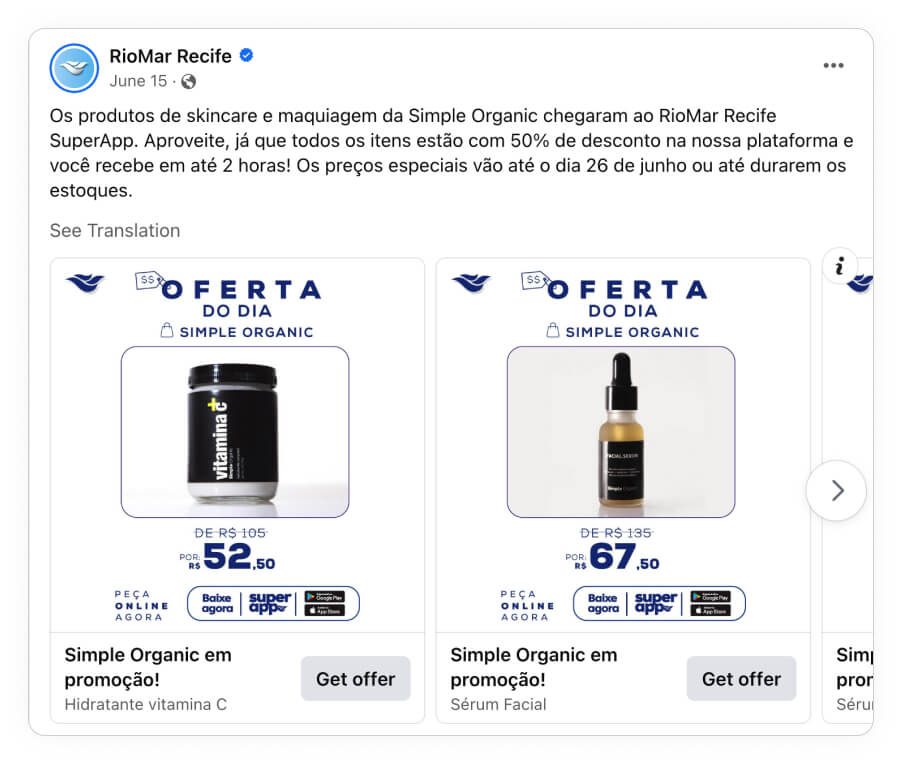
And, as you might have guessed, those aren't the only ways to create time-bound campaigns.
In the following beauty ad example, the advertiser chose to create a campaign sale around a 14 day period, which really helps drive a sense of urgency. If the viewer waits too long, they're going to miss out. And similarly, they've also included their logo and some pricing information, which is a guaranteed tactic to catch the viewer's attention.
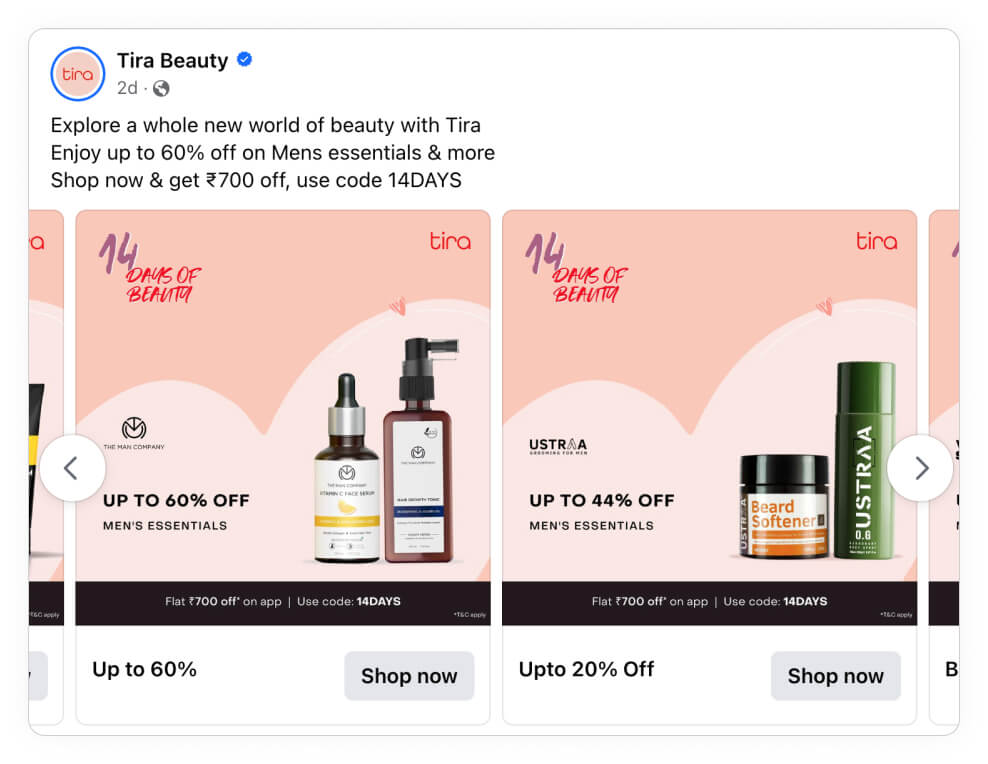
You don't need to have a sale or give discounts to run campaigns. Below is an example from MAC, which offers an exclusive brush holder if you buy from them for a limited time.
Giving free gifts away like this can be a great way to run a promotion without giving discounts - something more high-end brands can use as a replacement.
This can also be mixed with product-specific designs, such as if you only want to give your gift to specific categories (free brush holder if you buy a brush) or price points (free brush holder if you buy for more than $100).
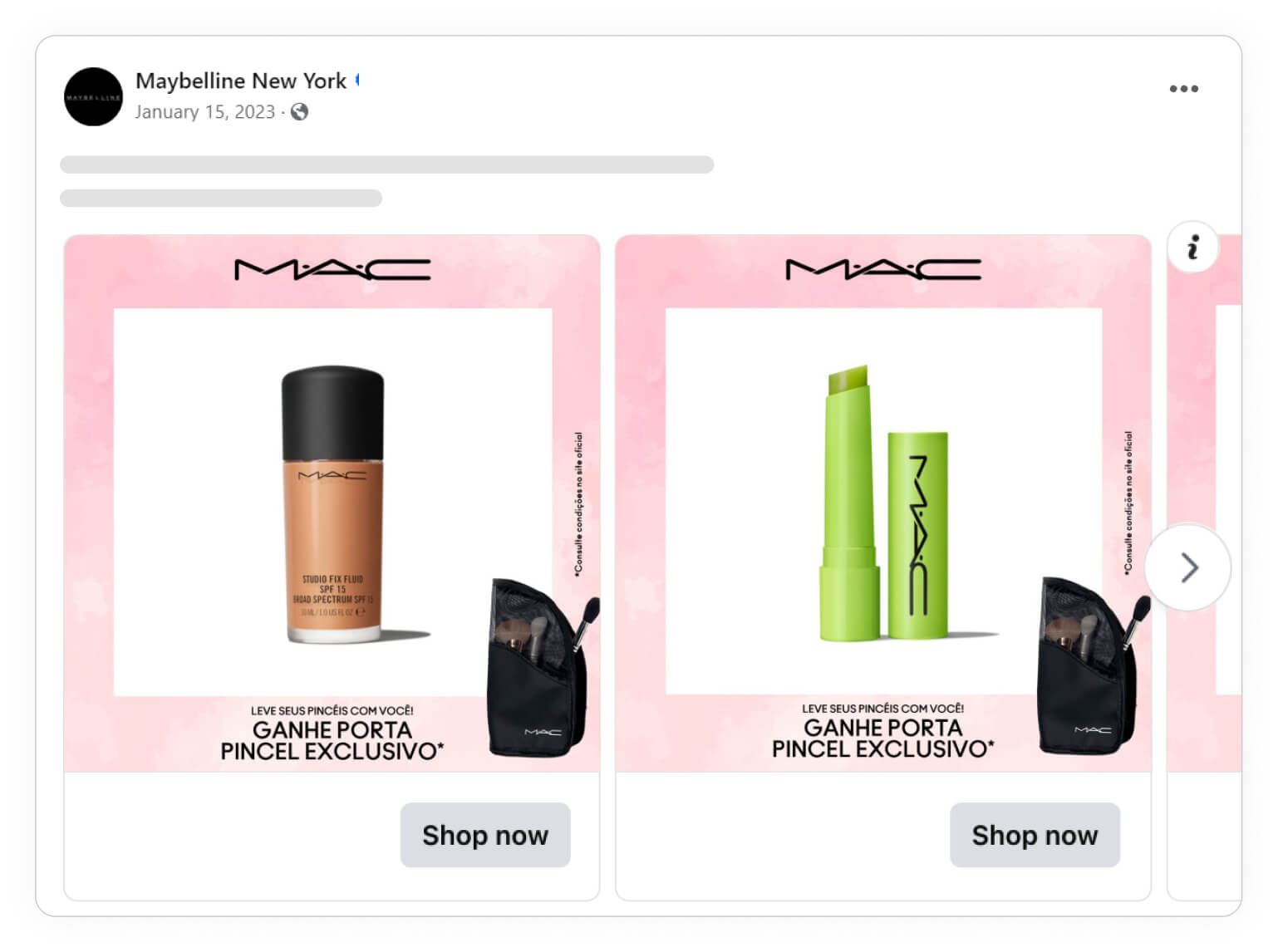
Most often, you'll see beauty brands create campaigns around holidays, calendar events, days or weeks. But there's really no limit to what type of campaign periods you can use. So don't be scared to think up new types of campaigns, put them to an A/B test, and see if they really hold up when live.
Benefits:
- Time-based campaigns can help create a sense of urgency in your ads, which can drive viewers to act sooner than later.
- Time-based campaigns can be based on holidays, seasons, calendar events, days, weeks, etc.
Disadvantages:
- Time-bound campaigns aren't evergreen, which means you'll need to regularly update your campaigns and create different campaigns when those time periods run out.
Just to summarize, the possibilities are virtually endless when it comes to creating time-based campaign sales for your beauty or cosmetic brand. You can and should get creative and play around with these Catalog Ad campaign ideas for your own brand.
Other sales tactics for cosmetics brands
By now, you should have a pretty good idea of how to create beauty ads that will resonate with your target audience. But before you run out and start your next advertising campaign, let's take a look at a few more tactics you can use.
Another great strategy is to increase sales on certain sets or categories of products. Just like this ad from Cozmetica, where they're promoting a sale on their New Arrivals. You can also think of other product sets to use, like low-stock items, popular items, or even just product sets based on categories (like lipstick, eyeliner, eye shadow, cover-up, etc.). We also love how they've included the percentage off discount, which is another nifty bit of pricing psychology that can help drive sales.
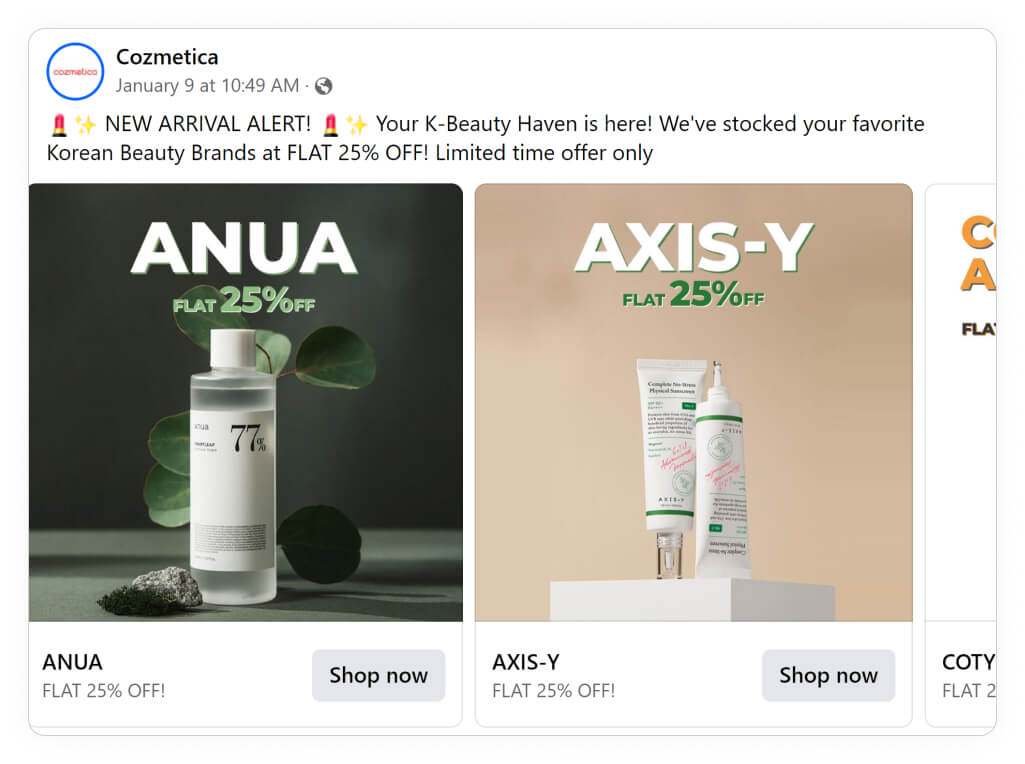
And finally, we have another great example of an always-on Catalog Ad ad that will be evergreen and relevant to whoever sees it, whenever they see it.
These types of always-on ads are great because all that changes in the design in the sales price and the regular price... This beauty brand is using information they already have at their disposal, so it's nothing new or hard to come by. And the thing to remember is that using relevant, valuable information in your beauty ads is a great way to level up your always-on Catalog Ads.
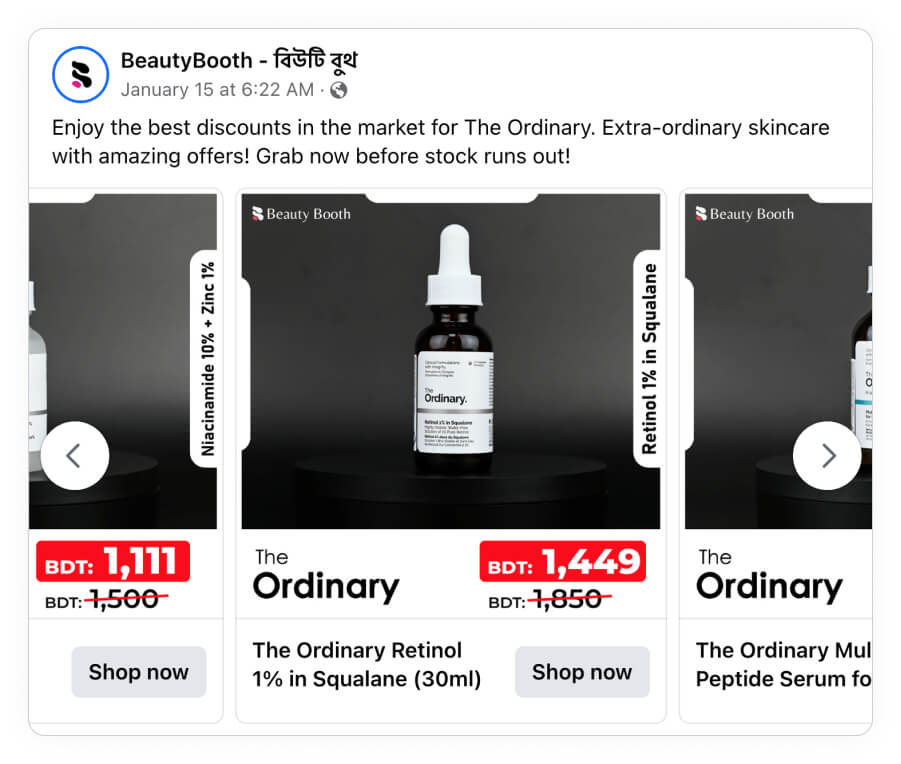
Creating Advantage+ Catalog Ads for beauty and cosmetic brands
Always remember that the tactics and strategies we've shown you here aren't magic recipes guaranteed to take your brand's beauty ads from zero to hero overnight.
However, they should be taken as inspiration to help guide you into making better, more informed advertising choices in the future.
But as always, we strongly encourage you to run A/B tests on your ads to find out what works and what doesn't work in your Catalog Ads.
And then, by doing more of what works, and less of what doesn't, your beauty brand will be well on its way to advertising success.
